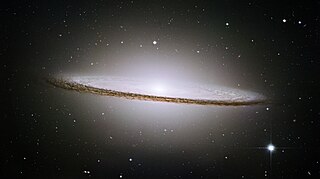 W
WA low-ionization nuclear emission-line region (LINER) is a type of galactic nucleus that is defined by its spectral line emission. The spectra typically include line emission from weakly ionized or neutral atoms, such as O, O+, N+, and S+. Conversely, the spectral line emission from strongly ionized atoms, such as O++, Ne++, and He+, is relatively weak. The class of galactic nuclei was first identified by Timothy Heckman in the third of a series of papers on the spectra of galactic nuclei that were published in 1980.
 W
WMessier 63 or M63, also known as NGC 5055 or the seldom-used Sunflower Galaxy, is a spiral galaxy in the northern constellation of Canes Venatici with approximately 400 billion stars. M63 was first discovered by the French astronomer Pierre Méchain, then later verified by his colleague Charles Messier on June 14, 1779. The galaxy became listed as object 63 in the Messier Catalogue. In the mid-19th century, Anglo-Irish astronomer Lord Rosse identified spiral structures within the galaxy, making this one of the first galaxies in which such structure was identified.
 W
WMessier 94 is a spiral galaxy in the constellation Canes Venatici. It was discovered by Pierre Méchain in 1781, and catalogued by Charles Messier two days later. Although some references describe M94 as a barred spiral galaxy, the "bar" structure appears to be more oval-shaped. The galaxy has two ring structures.
 W
WNGC 266 is a massive barred spiral galaxy in the constellation Pisces. NGC 266 is located at a distance of 197 megalight-years from the Milky Way. It was discovered on September 12, 1784 by William Herschel. The form of this barred galaxy is described by its morphological classification of SB(rs)ab, which indicates a quasi-ring-like structure (rs) and moderate-to-tightly wound spiral arms (ab). It is the dominant member of a small group with six low-mass galaxies.
 W
WNGC 404 is a field galaxy located about 10 million light years away in the constellation Andromeda. It was discovered by William Herschel in 1784, and is visible through small telescopes. NGC 404 lies just beyond the Local Group and does not appear gravitationally bound to it. It is located within 7 arc-minutes of second magnitude star Mirach, making it a difficult target to observe or photograph and granting it the nickname "Mirach's Ghost".
 W
WNGC 1637 is an isolated, non-interacting intermediate spiral galaxy in the constellation Eridanus, about a degree to the WNW of the star Mu Eridani. It is located at a distance of about 9.77 ± 1.82 Mpc (31.9 ± 5.9 Mly) from the Milky Way. The galaxy is inclined at an angle of 31.1° to the line of sight from the Earth and the long axis is oriented along a position angle of 16.3°.
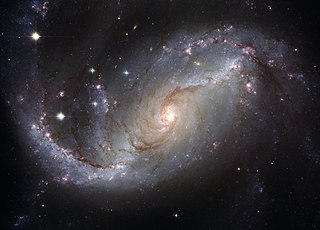 W
WNGC 1672 is a barred spiral galaxy located in the constellation Dorado. It was originally thought to be a member of the Dorado Group, however, this membership was later rejected. NGC 1672 has a large bar which is estimated to measure around 20 kpc. It has very strong radio emissions emanating from its nucleus, bar, and the inner portion of the spiral arm region. The nucleus is Seyfert type 2 and is engulfed by a starburst region. The strongest polarized emissions come from the northeastern region which is upstream from its dust lanes. Magnetic field lines are at large angles with respect to the bar and turn smoothly to the center.
 W
WNGC 2787 is a barred lenticular galaxy approximately 24 million light-years away in the northern circumpolar constellation of Ursa Major. It was discovered on December 3, 1788 by German-born astronomer William Herschel. J. L. E. Dreyer described it as, "bright, pretty large, a little extended 90°, much brighter middle, mottled but not resolved, very small (faint) star involved to the southeast". The visible galaxy has an angular size of 2′.5 × 1′.5 and an apparent visual magnitude of 11.8.
 W
WNGC 2841 is an unbarred spiral galaxy in the northern circumpolar constellation of Ursa Major. It was discovered on 9 March 1788 by German-born astronomer William Herschel. J. L. E. Dreyer, the author of the New General Catalogue, described it as, "very bright, large, very much extended 151°, very suddenly much brighter middle equal to 10th magnitude star". Initially thought to be about 30 million light-years distant, a 2001 Hubble Space Telescope survey of the galaxy's Cepheid variables determined its distance to be approximately 14.1 megaparsecs or 46 million light-years. The optical size of the galaxy is 8.′1 × 3.′5.
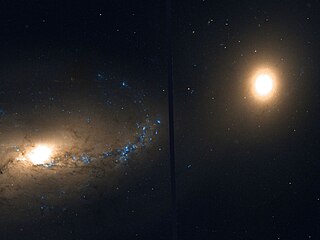 W
WNGC 3226 is a dwarf elliptical galaxy that is interacting with the spiral galaxy NGC 3227. The two galaxies are one of several examples of a spiral with a dwarf elliptical companion that are listed in the Atlas of Peculiar Galaxies. Both galaxies may be found in the constellation Leo.
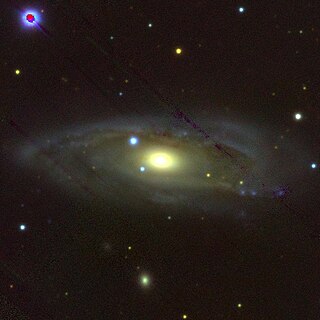 W
WNGC 3312 is a large and highly inclined spiral galaxy located about 194 million light-years away in the constellation Hydra. The galaxy was discovered by astronomer John Herschel on March 26, 1835. It was later rediscovered by astronomer Guillaume Bigourdan on February 26, 1887. NGC 3312 was later listed and equated with IC 629 because the two objects share essentially the same celestial coordinates. NGC 3312 is the largest spiral galaxy in the Hydra Cluster and is also classified as a LINER galaxy.
 W
WNGC 3558 is an elliptical or a lenticular galaxy located 440 million light-years away in the constellation Ursa Major. It was discovered by the astronomer Heinrich d'Arrest on April 15, 1866. It is a member of the galaxy cluster Abell 1185 and is classified as a LINER galaxy.
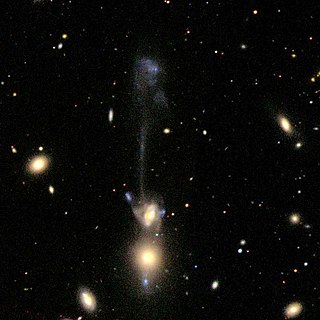 W
WNGC 3561, also known as Arp 105, is a pair of interacting galaxies NGC 3561A and NGC 3561B within the galaxy cluster Abell 1185 in Ursa Major. Its common name is "the Guitar" and contains a small tidal dwarf galaxy known as Ambartsumian's Knot that is believed to be the remnant of the extensive tidal tail pulled out of one of the galaxies.
 W
WNGC 3861 is a large barred spiral galaxy with a ring-like structure located about 310 million light-years away in the constellation Leo. It was discovered by astronomer John Herschel on March 23, 1827. NGC 3861 is a member of the Leo Cluster and has a normal amount of neutral hydrogen and ionised hydrogen.
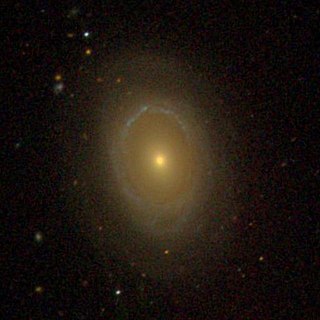 W
WNGC 3884 is a spiral galaxy located about 330 million light-years away in the constellation Leo. The galaxy was discovered by astronomer William Herschel on April 27, 1785 and is a member of the Leo Cluster.
 W
WNGC 4060 is a lenticular galaxy located 320 million light-years away in the constellation Coma Berenices. It was discovered by astronomer Albert Marth on March 18, 1865 and is a member of the NGC 4065 Group which is part of the Coma Supercluster.
 W
WNGC 4070 is an elliptical galaxy located 340 million light-years away in the constellation Coma Berenices. NGC 4070 was discovered by astronomer William Herschel on April 27, 1785. It was rediscovered by John Herschel on April 29, 1832 and was listed as NGC 4059. The galaxy is a member of the NGC 4065 Group.
 W
WNGC 4072 is a lenticular galaxy located 300 million light-years away in the constellation Coma Berenices. The galaxy was discovered by astronomer Ralph Copeland on April 3, 1872 and is a member of the NGC 4065 Group.
 W
WNGC 4076 is a spiral galaxy located 290 million light-years away in the constellation Coma Berenices. The galaxy was discovered by astronomer William Herschel on April 27, 1785 and is a member of the NGC 4065 Group.
 W
WNGC 4084 is an elliptical galaxy located 315 million light-years away in the constellation Coma Berenices. NGC 4084 was discovered by astronomer Heinrich d'Arrest on April 26, 1865. NGC 4084 is an isolated member of the Coma Supercluster and is classified as a LINER galaxy.
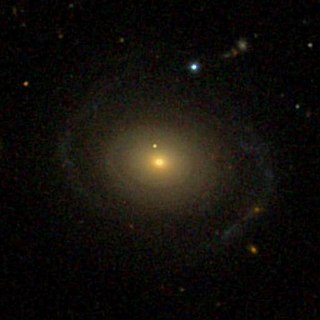 W
WNGC 4086 is a lenticular galaxy located 330 million light-years away in the constellation Coma Berenices. NGC 4086 was discovered by astronomer Heinrich d'Arrest on May 2, 1864 and is a member of the NGC 4065 Group.
 W
WNGC 4091 is a spiral galaxy located 360 million light-years away in the constellation Coma Berenices. The galaxy was discovered by astronomer Heinrich d'Arrest on May 2, 1864. NGC 4091 is a member of the NGC 4065 Group and is a LINER galaxy.
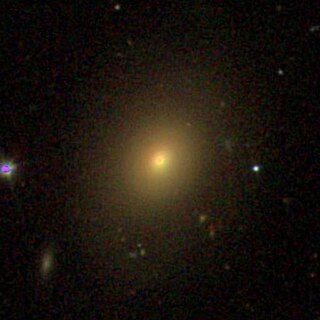 W
WNGC 4095 is an elliptical galaxy located 330 million light-years away in the constellation Coma Berenices. The galaxy was discovered by astronomer William Herschel on April 26, 1785. NGC 4095 is a member of the NGC 4065 Group and is a LINER.
 W
WNGC 4102 is an intermediate spiral galaxy located in the northern constellation of Ursa Major. The galaxy contains a LINER region and a starburst region. The starburst region is 1,000 ly (310 pc) in diameter containing some 3 billion solar masses.
 W
WNGC 4212 is a flocculent spiral galaxy with LINER activity located about 53 million light-years away in the constellation Coma Berenices. The galaxy was discovered by astronomer William Herschel on April 8, 1784 and was listed in the NGC catalog as NGC 4208. He then observed the same galaxy and listed it as NGC 4212. Astronomer John Louis Emil Dreyer later concluded that NGC 4208 was identical to NGC 4212. NGC 4212 is a member of the Virgo Cluster.
 W
WNGC 4237 is a flocculent spiral galaxy located about 60 million light-years away in the constellation Coma Berenices. The galaxy was discovered by astronomer William Herschel on December 30, 1783 and is a member of the Virgo Cluster. It is also classified as a LINER galaxy and as a Seyfert galaxy.
 W
WNGC 4293 is a lenticular galaxy in the northern constellation of Coma Berenices. It was discovered by English astronomer William Herschel on March 14, 1784, who described it as "large, extended, resolvable, 6 or 7′ long". This galaxy is positioned to the north-northwest of the star 11 Comae Berenices and is a member of the Virgo Cluster of galaxies. It is assumed to lie at the same distance as the Virgo Cluster itself: around 54 million light years away. The galaxy spans an apparent area of 5.3 × 3.1 arc minutes.
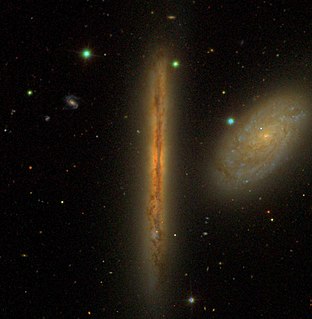 W
WNGC 4302 is an edge-on spiral galaxy located about 55 million light-years away in the constellation Coma Berenices. It was discovered by astronomer William Herschel on April 8, 1784 and is a member of the Virgo Cluster.
 W
WNGC 4307 is an edge-on spiral galaxy located about 65 million light-years away in the constellation Virgo. It was discovered by astronomer Christian Peters in 1881 and is a member of the Virgo Cluster. It is also a LINER galaxy.
 W
WNGC 4312 is an edge-on spiral galaxy located about 55 million light-years away in the constellation Coma Berenices. It was discovered by astronomer William Herschel on January 14, 1787. NGC 4312 is a member of the Virgo Cluster and is a LINER galaxy.
 W
WNGC 4313 is an edge-on spiral galaxy located about 50 million light-years away in the constellation Virgo. It was discovered by astronomer William Herschel on March 15, 1784. NGC 4313 is a member of the Virgo Cluster and is classified as LINER and as a Seyfert galaxy.
 W
WNGC 4316 is an edge-on spiral galaxy located about 70 million light-years away in the constellation Virgo. It was discovered by astronomer Wilhelm Tempel on March 17, 1882. NGC 4316 is a member of the Virgo Cluster and is classified as LINER and as a Seyfert galaxy.
 W
WNGC 4457 is a spiral galaxy located about 55 million light-years away in the constellation of Virgo. It is also classified as a LINER galaxy, a class of active galaxy defined by their spectral line emissions. NGC 4457 Is inclined by about 33°. It was discovered by astronomer William Herschel on February 23, 1784. Despite being listed in the Virgo Cluster Catalog as VCC 1145, NGC 4457 is a member of the Virgo II Groups which form an extension of the Virgo cluster.
 W
WNGC 4459 is a lenticular galaxy located about 50 million light-years away in the constellation of Coma Berenices. NGC 4459 is also classified as a LINER galaxy. NGC 4459 was discovered by astronomer William Herschel on January 14, 1787. NGC 4459 is a member of the Virgo Cluster.
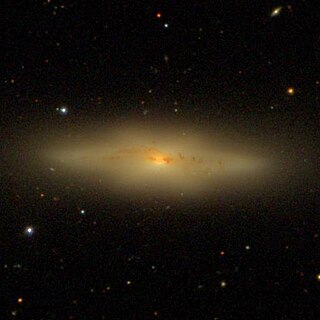 W
WNGC 4469 is a nearly edge-on spiral galaxy located about 55 million light-years away in the constellation of Virgo. It is also classified as a LINER galaxy. NGC 4469 was discovered by astronomer William Herschel on April 15, 1784. It is a member of the Virgo Cluster.
 W
WNGC 4580 is an unbarred spiral galaxy located about 70 million light-years away in the constellation Virgo. NGC 4580 is also classified as a LINER galaxy. It was discovered by astronomer William Herschel on February 2, 1786 and is a member of the Virgo Cluster.
 W
WNGC 4689 is a spiral galaxy located about 54 million light-years away in the constellation of Coma Berenices. NGC 4689 is also classified as a LINER galaxy. NGC 4689 is inclined at an angle of about 36° which means that the galaxy is seen almost face-on to the Earth's line of sight. NGC 4689 was discovered by astronomer William Herschel on April 12, 1784. The galaxy is a member of the Virgo Cluster.
 W
WNGC 4762 is an edge-on lenticular galaxy in the constellation Virgo. It is at a distance of 60 million light years and is a member of the Virgo Cluster. The edge-on view of this particular galaxy, originally considered to be a barred spiral galaxy, makes it difficult to determine its true shape, but it is considered that the galaxy consists of four main components — a central bulge, a bar, a thick disc and an outer ring. The galaxy's disc is asymmetric and warped, which could be explained by NGC 4762 mergering with a smaller galaxy in the past. The remains of this former companion may then have settled within NGC 4762's disc, redistributing the gas and stars and so changing the disc's morphology.
 W
WNGC 4892 is a spiral or lenticular galaxy with LINER activity located 275 million light-years away in the constellation Coma Berenices. It was discovered by the astronomer William Herschel on April 11, 1785, and is a member of the Coma Cluster.
 W
WNGC 4907 is a barred spiral galaxy located about 270 million light-years away in the constellation of Coma Berenices. It is also classified as a LINER galaxy. NGC 4907 was discovered by astronomer Heinrich d'Arrest on May 5, 1864. The galaxy is a member of the Coma Cluster.
 W
WNGC 5005, also known as Caldwell 29, is an inclined spiral galaxy in the constellation Canes Venatici. The galaxy has a relatively bright nucleus and a bright disk that contains multiple dust lanes. The galaxy's high surface brightness makes it an object that is visible to amateur astronomers using large amateur telescopes.
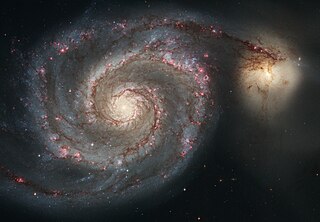 W
WNGC 5195 is a dwarf galaxy that is interacting with the Whirlpool Galaxy. Both galaxies are located approximately 25 million light-years away in the constellation Canes Venatici. Together, the two galaxies are one of the most famous interacting galaxy pairs.
 W
WNGC 6045 is a barred spiral galaxy located about 450 million light-years away in the constellation Hercules. NGC 6045 was discovered by astronomer Lewis Swift on June 27, 1886 and is a member of the Hercules Cluster. It is also a LINER galaxy.
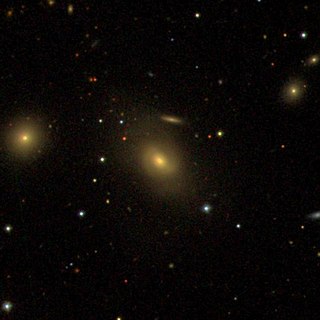 W
WNGC 6055 is a barred lenticular galaxy located about 450 million light-years away in the constellation Hercules. The galaxy was discovered by astronomer Lewis Swift on June 8, 1886. It also a member of the Hercules Cluster and is a LINER galaxy.
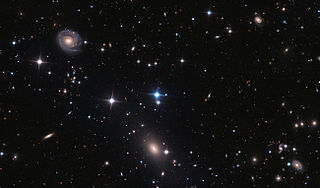 W
WNGC 6085 is a spiral galaxy in the constellation of Corona Borealis. It is classified as a LINER galaxy and is a member of Abell 2162.
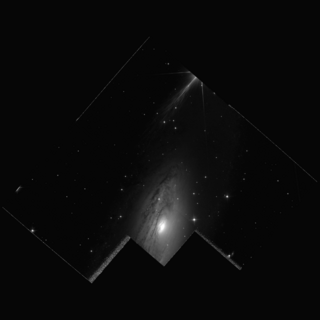 W
WNGC 7013 is a relatively nearby spiral or lenticular galaxy estimated to be around 37 to 41.4 million light-years away from Earth in the constellation of Cygnus. NGC 7013 was discovered by English astronomer William Herschel on July 17, 1784 and was also observed by his son, astronomer John Herschel on September 15, 1828.
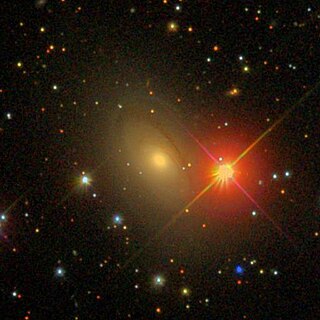 W
WNGC 7025 is a spiral galaxy located about 210 million Light-years away from Earth in the constellation Delphinus. NGC 7025 is also classified as a LINER galaxy. The galaxy has an estimated diameter of 161,830 light-years. It was discovered by astronomer Albert Marth on September 17, 1863.
 W
WNGC 7046 is a barred spiral galaxy located about 180 million light-years away in the constellation of Equuleus. NGC 7046 is also classified as a LINER-type galaxy. NGC 7046 has an estimated diameter of 106,990 light-years. NGC 7046 was discovered by astronomer William Herschel on October 10, 1790.
 W
WNGC 7047 Is an intermediate spiral galaxy located about 270 million light-years away in the constellation of Aquarius. NGC 7047 is also classified as a LINER-type galaxy. NGC 7047 has an estimated diameter of 127,350 light-years. It was discovered by French astronomer Édouard Stephan on August 20, 1873. In 2009 a supernova was found in NGC 7047.
 W
WNGC 7069 is a Lenticular galaxy located about 400 million light-years away in the constellation of Aquarius. NGC 7069 is also classified as a LINER galaxy. NGC 7069 was discovered by astronomer Albert Marth on October 12, 1863.
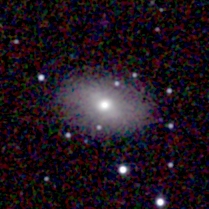 W
WNGC 7079 is a barred lenticular galaxy located about 110.58 million light-years away in the constellation of Grus. NGC 7079 is also classified as a LINER galaxy. It is tilted about 51° to the Earth's line of sight. NGC 7079 was discovered by astronomer John Herschel on September 6, 1834.
 W
WThe Sombrero Galaxy is a spiral galaxy in the constellation borders of Virgo and Corvus, being about 9.55 megaparsecs from Earth. The galaxy has a diameter of approximately 15 kiloparsecs, 30% the size of the Milky Way. It has a bright nucleus, an unusually large central bulge, and a prominent dust lane in its inclined disk. The dark dust lane and the bulge give this galaxy the appearance of a sombrero hat. Astronomers initially thought that the halo was small and light, indicative of a spiral galaxy, but the Spitzer Space Telescope found that the dust ring around the Sombrero Galaxy is larger and more massive than previously thought, indicative of a giant elliptical galaxy. The galaxy has an apparent magnitude of +8.0, making it easily visible with amateur telescopes, and it is considered by some authors to be the galaxy with the highest absolute magnitude within a radius of 10 megaparsecs of the Milky Way. Its large bulge, its central supermassive black hole, and its dust lane all attract the attention of professional astronomers.